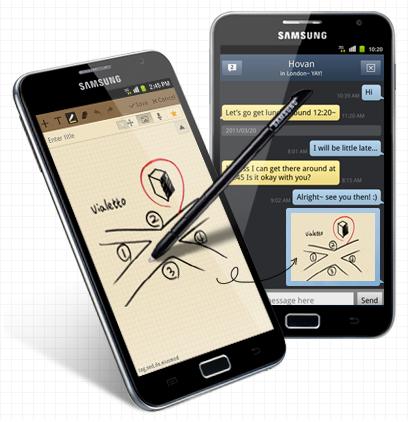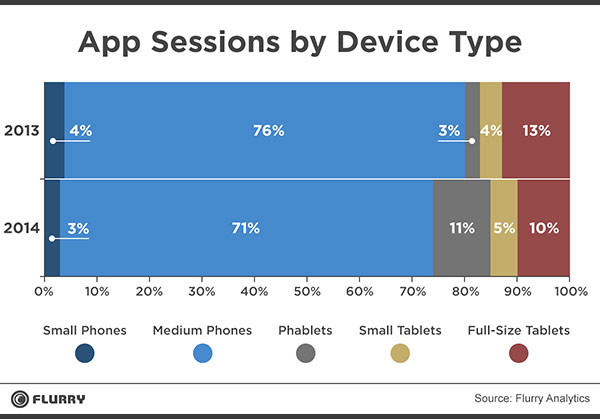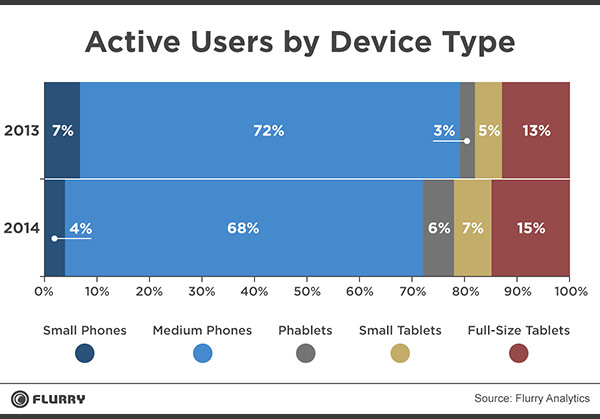Bigger Screen Sizes Lead To More App Engagement, Report Shows
Sams
ung’s 5.3” Galaxy Note started a “phablet” trend in 2011 that a lot of other OEMs have started to follow to the point where we’re now seeing almost all mobile OEMs building devices that are 5” or bigger. Even Apple is rumored to be launching a 5.5" iPhone in the next few days as one of the last OEMs to join the phablet trend.
Flurry (a mobile app analytics company recently acquired by Yahoo) has released a report that shows that “phablet” sales have not just doubled over the past year, becoming 6 percent of the mobile devices installed base, but that app activity on phablets accounts for 11 percent of all app sessions.
The Android ecosystem has long been criticized that it doesn’t have high app usage and that most of people buying Android smartphones use them as regular phones or features phones. Now we know why that was -- to keep costs low, the OEMs have been selling low-end Android smartphones with 3.5” screens or lower for a long time, which apparently has lead to low app engagement on these phones.
On such phones it’s hard enough to type a text message due to the restricted screen space for the virtual keyboard, let alone use them for long periods of times to play with apps. Of course there have been other factors influencing app usage, too, such as low internal storage not allowing for too many apps to be installed, slow processors, low amounts of RAM, and so on. But with the cost of the components dropping about 30 percent every year, and with the trend to use bigger and bigger screens on mobile devices, the low-end smartphones are bound to get bigger screens as well as faster processors and more storage and RAM.
Google has also recently been pushing its Android One program for low-end smartphones, and one of the requirements is having a minimum screen size of 4.5”. It’s probably why Google has messed with the Moto X formula by increasing its screen size from 4.7” to a significantly larger 5.2” size, and why the Nexus X/Nexus 5 2014 is rumored to have a 5.2” screen, too.
Flurry’s report also shows that of all Android users, 18 percent already use phablets, compared to only 7 percent in 2013. At the same time, demand for medium phones (3.5”-4.9”) shrank by 9 percent, while demand for small phones (under 3.5”) shrank by 4 percent.
Get Tom's Hardware's best news and in-depth reviews, straight to your inbox.
The demand for small phones didn’t drop as much likely because its users tend to be either older people who prefer smaller phones, and are less likely to change their habits, or because companies are still trying to push Android smartphones at even lower price levels. That means OEMs have to continue to cut corners on their components in order to lower the price as much as possible. However, the trend towards bigger screens is inevitable, even at this level.
According to Flurry’s report, phablet users seem to be no different than smaller phone users who have simply “upgraded” their devices to bigger screens. It’s interesting to see that bigger screens also lead to an increase in book reading. Although phablet users represent 6 percent of the mobile market, they account for 10 percent of book reading on mobile devices.
Just like with the increase in app activity, this doesn’t mean phablet users tend to love books more than everyone else. Even if a user would like to read books on her mobile device, it's difficult if the screen is too small. On the other hand, the bigger the screen, the easier and more comfortable reading becomes, and the users who would like to read books are now able to do it properly.
Over the next few years we can expect OEMs to become increasingly more aggressive about adopting larger screens, not just at the high-end (where they will probably stop around 5.5”-5.7” in size), but across their entire product line-ups. In Asian markets, 5”-plus phablets that come with lower resolutions, slower processors and generally cheaper components (and cost $200-$300) are already pretty popular. We’ll likely see that trend go both deeper (at lower price levels) and wider (in more countries and markets), until almost everyone has a “phablet” that provides them with a better experience for using apps, reading books, watching movies or playing games, thanks to the bigger screen size.
Follow us @tomshardware, on Facebook and on Google+.
Lucian Armasu is a Contributing Writer for Tom's Hardware US. He covers software news and the issues surrounding privacy and security.
-
InvalidError I am not surprised to see reading as one of the favored uses for small-medium tablets. I probably spend more than 90% of my time on my N7 reading - the main use I bought the thing in the first place, with a secondary reason being for use as a WiFi VoIP phone.Reply -
chicofehr Am I the only one finding the smartphone thing boring? I have several from different brands from Blackberry, Android and iOS and I still spend 10x as much time in front of my computer when I'm at home. No time to play when I'm at work so I don't use them much there.Reply -
ceh4702 I wonder how you use the term reading. Is that reading books? I am a Mormon and I use an LDS App that lets me access the bible and other religious texts, class manuals, church magazines, conference talks, hymn books, videos, etc. Our church is trying to encourage people to use phones and tablets to keep from printing class materials. It also means you don't have to carry all that around.Reply



